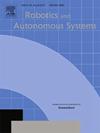Neuro compensated sliding mode control with nonlinear surfaces for pipe crack sealing manipulator
IF 4.3
2区 计算机科学
Q1 AUTOMATION & CONTROL SYSTEMS
引用次数: 0
Abstract
This work focuses on ensuring control over the pipe crack sealing manipulator (PCSM) to seal the cracks within concrete pipes. PCSM is a tree-shaped robot featuring five specialised branches, suggesting a multifunctional design for crack-sealing operation within the pipe. PCSM demonstrates versatility in navigating vertical and horizontal pipes. A CAD model featuring the pipe, target crack, and PCSM has been modelled in SolidWorks, Utilising crack data from SolidWorks, the inverse kinematics and dynamics of the model are being simulated in Simulink for precise control. Observation and simulations study in SoildWorks revealed that only the fifth branch of PCSM successfully executed crack repairs over a substantial length. The tracing of the actual crack trajectory for effective sealing within the concave pipe becomes more challenging in the presence of disturbances and uncertainty in the system. To address this issue, sliding mode control (SMC) is employed with a nonlinear surface (SMCNS), which proves effective in handling external disturbances and uncertainty. To enhance control performance, a neural network (NN) compensator is combined with SMCNS and the proposed controller is called neuro-compensated sliding mode control with the nonlinear surface (NCSMCNS). The incorporation of a neural network with a nonlinear surface leads to the convergence of tracking error to zero, a conclusion validated through the use of Lyapunov theory. Furthermore, the performance of the proposed controller has been compared with SMC (linear and non-linear surface) and neuro-compensated SMC (linear surface).
管道裂缝密封机械手非线性曲面的神经补偿滑模控制
本文的工作重点是确保对管道裂缝密封机械手(PCSM)的控制,以密封混凝土管道内的裂缝。PCSM是一个树形机器人,有五个专门的分支,表明了管道内裂缝密封操作的多功能设计。PCSM展示了垂直和水平管道导航的通用性。在SolidWorks中对管道、目标裂纹和PCSM的CAD模型进行了建模,利用SolidWorks中的裂纹数据,在Simulink中对模型的逆运动学和动力学进行了仿真,以实现精确控制。SoildWorks的观察和模拟研究表明,只有第五支PCSM成功地完成了相当长度的裂缝修复。在系统中存在干扰和不确定性的情况下,追踪凹管内有效密封的实际裂纹轨迹变得更具挑战性。为了解决这一问题,滑模控制(SMC)采用非线性表面(SMCNS),被证明是有效的处理外部干扰和不确定性。为了提高控制性能,将神经网络(NN)补偿器与SMCNS相结合,并将所提出的控制器称为具有非线性表面的神经补偿滑模控制(NCSMCNS)。利用李亚普诺夫理论验证了具有非线性曲面的神经网络可以使跟踪误差收敛到零。此外,还将所提控制器的性能与线性和非线性曲面(SMC)和神经补偿的线性曲面(SMC)进行了比较。
本文章由计算机程序翻译,如有差异,请以英文原文为准。
求助全文
约1分钟内获得全文
求助全文
来源期刊

Robotics and Autonomous Systems
工程技术-机器人学
CiteScore
9.00
自引率
7.00%
发文量
164
审稿时长
4.5 months
期刊介绍:
Robotics and Autonomous Systems will carry articles describing fundamental developments in the field of robotics, with special emphasis on autonomous systems. An important goal of this journal is to extend the state of the art in both symbolic and sensory based robot control and learning in the context of autonomous systems.
Robotics and Autonomous Systems will carry articles on the theoretical, computational and experimental aspects of autonomous systems, or modules of such systems.
 求助内容:
求助内容: 应助结果提醒方式:
应助结果提醒方式:


